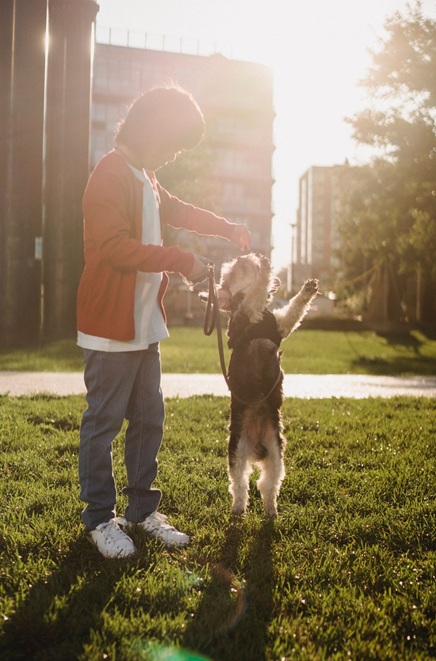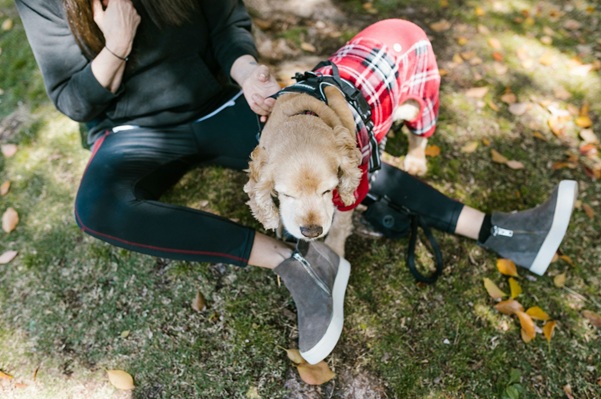 Walking a dog is one of the most memorable bonding moments for dog owners and their pets. However, walking dogs is not always easy, especially the big dogs. They are usually excited to go out. Thus, they pull against the leash so much that it hurts them sometimes. They could choke themselves out of excitement if you don’t act fast enough. Big pooches are worse; they could pull you along with the leash if you’re not fit enough.
Walking a dog is one of the most memorable bonding moments for dog owners and their pets. However, walking dogs is not always easy, especially the big dogs. They are usually excited to go out. Thus, they pull against the leash so much that it hurts them sometimes. They could choke themselves out of excitement if you don’t act fast enough. Big pooches are worse; they could pull you along with the leash if you’re not fit enough.
It is illegal to take a dog out in public without a leash in some regions or locations. This rule is mainly to ensure the safety of the dog, people, and other animals. Thus, a collar or harness is mandatory if they must go outside. To keep them safe and comfortable, the type of leash you use on them is crucial.
Traditional collars are designed to make dogs easier to train and control. Meanwhile, a harness makes the security of the dog its priority. Harnesses grab onto the body of dogs to prevent accidents. Thanks to the fastening efficiency of a harness, dogs hardly slip out of their collars.
If you are yet to decide, we’ll make it easier for you. A harness is better for your dog’s health than a collar, and we have evidence. Here are the top reasons why you should get a harness for your dog instead of a collar.

Your Dog Will Avoid Neck Injuries With A Harness
Using a collar makes it easier for dogs to hurt themselves. Collars pull on the trachea, which could cause pain in the neck and vertebrae. On the other hand, a harness counters the effects of a collar on the trachea or vertebrae. The design helps to distribute the pressure on the dog evenly throughout its upper body.
Meanwhile, using a collar puts nearly all the pressure on the dog’s neck. With this arrangement, dogs would still be safe even when they pull on the leash. Measure the shoulders, back, and chest areas of the dog before buying a harness. Consider buying no-pull harnesses; they are a peculiar type. They reduce the pulling and redirect the dog towards the owner whenever they pull on the harness.

Avoid Tripping on a Tangled Leash
Another challenge with walking dogs is that they sometimes get entangled in their leash. Due to their excitement, they could twist the leash multiple times until they get trapped in it. Using a collar does not make it any better. In truth, it can be funny to watch. Not only can a dog entangle itself on a leash, but it can entangle its owner as well.
However, a dog will hardly entangle itself or its walker if the leash is from behind. Fortunately, dog walkers can attach the leash either from the front or from behind with a harness. When next you shop dog harnesses, ensure that they have both the front and backside attachment options.

Harnesses Are Suitable For Dogs With Medical Issues
Taking dogs with specific medical issues out for a walk is a concern for their owners. Using a collar to walk dogs with spinal (or neck) injuries or glaucoma adds to their discomfort. Sometimes, they move in the wrong direction due to their medical issues. In response, the dog walker would attempt to steer them the opposite way. By doing this, the collar only hurts the dogs even more.
Other medical conditions, like trachea collapse, make it hard for dogs to breathe. Using a collar only worsens their situation as it blocks the airways whenever they pull on the collar. Likewise, dogs with a history of orthopedic and spinal issues should never wear a collar. However, a harness is ideal for dogs with these medical conditions and more. A harness will help to relieve the pressure on these dogs while controlling them.

Harnesses Offer More Control For The Dog Owner
One of the biggest challenges of walking a dog is controlling them. Since dogs mostly stay indoors, going outside excites them. Thus, make sure to have a good grasp of the harness before leaving the house. Else, they might run into traffic. Virtually anything would easily distract a dog. From unfriendly faces to funny objects on the ground to other animal breeds, dogs would run after anything interesting.
Nearly every dog is difficult to manage in these circumstances, especially the big ones. However, with a harness, controlling them without hurting them is much easier than with a collar. Harnesses are fastened to the body of dogs to prevent accidents. Thanks to the fastening potential of a harness, dogs hardly slip out of their collars.
Conclusion
Dogs don’t know any better. They can also be their own worst enemy when they go out for a walk. Not only would they eat objects on the ground, but they also pull against their leash. Doing this could choke them or lead to various injuries. When it comes to keeping a pet under control, a collar does the job as well as a harness. Yet, a harness holds more benefits for both the dog owner and the dog. Besides the safety and control it affords the dog and its owner, a harness is also safe and secure. After all, if collars were perfect, there wouldn’t be harnesses.